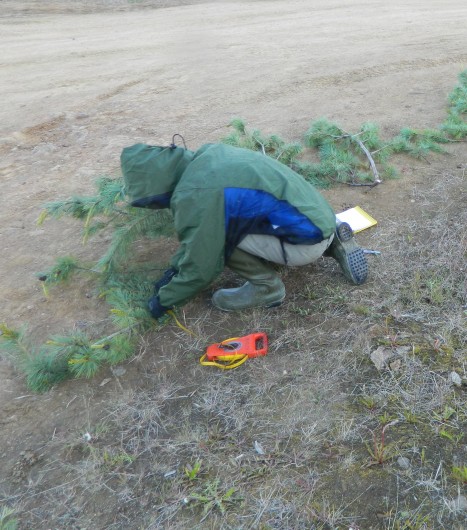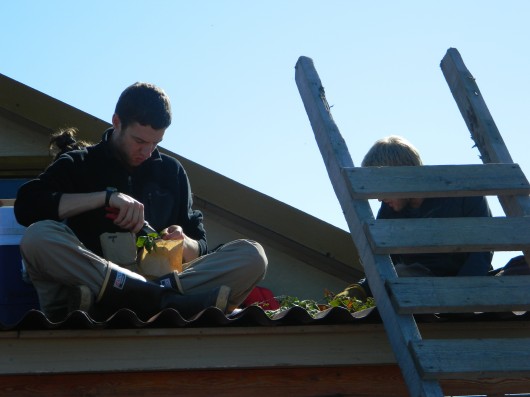In ecology, a fundamental objective is taking our measurements, observations, and analyses from a manageable sampling and scaling these up to assess their implications on a large landscape. While remote sensing and modeling are a key part of ecological research, having reliable data from the field to ‘ground truth’ these techniques is equally crucial.

Logan Berner measuring Dwarf Siberian Pines
This year, Logan Berner (Woods Hole Research Center) and I decided to undertake an ambitious project in the Cherskiy area utilizing allometry, a method of relating a simple measurement to a more complex one using mathematical equations. Allometry, by definition, has its roots in animal biology but has useful applications in ecology as well. In forest ecology, scientists have used allometry to relate basal diameter (BD) or diameter at breast height (DBH) of trees to overall tree biomass, a useful figure important in understanding carbon pools and analysis of large scale forest landscapes. A significant sample size and breadth of tree size classes are important to have robust, accurate allometric equations. There are reliable equations for many tree species and those that cover many wide geographic areas. These provide those interested in forest biomass a simple method of measurement and relation without each research team (needlessly) harvesting, drying, and weighing whole trees. Lacking, however, is allometry data from important parts of the world where field data and logistics are complicated, such as Northern Russia. In addition, little has been done with allometry of another prominent biomass component in boreal forest – shrubs. This is where our work comes in.

Scott Zolkos and Logan Berner clip dwarf birch and alder samples aboard the barge en route to Duvanny Yar
We are interested in shrubs because of their significant biomass contribution and also their potential for more rapid changes in composition and extent than trees under global climate change. Shrubs are (usually) short statured, multi-stemmed plants that form ground cover in many types of ecosystems. The process for developing useful equations first involves harvesting the shrubs, measuring basal diameter, height, and length in the field. Many a post-dinner night was spent partitioning shrubs into new growth and reproductive parts, branches, leaves, and bole (main stem). These parts are then put in the sauna for coarse drying, then oven dried to achieve dry mass of the samples. We desired a sample size of 20-30 samples per species and a wide range of sizes, from the very smallest shrubs all way up to 6 meter tall giants.
For this study, we chose four common species which comprise most of the shrub biomass in the Kolyma region. The shrubs are: Dwarf Siberian Pine (Pinus pumila), Alder (Alnus spp.), Willow (Salix spp.), and Dwarf Birch (Betula nana subsp. exilis). It has proven challenging to separate and dry this large amount of biomass in our short time at the station, but we hope the information will be useful for future research both at Northeast Science Station and throughout the boreal region. Our preliminary results show a good relation of basal diameter to biomass of these shrubs. Additionally, they also compare quite well to allometry data collected about shrubs in interior Alaska. By partitioning the various parts of the plant, we can hope to say something about size of shrubs and their yearly new growth, for example. Most often, biomass increases in an exponential form with increase in basal diameter. By fitting a power equation to relate our diameter to biomass measurements, we can sample anywhere in the region and comfortably relate a simple basal diameter measurement to shrub biomass anywhere in the size range of our allometry samples.
We hope to expand our sample sizes in future years and expand the range of our collection to other regions and landscape positions. Sampling for allometry, in the words of some of the 2012 Polaris Project members, has become an addiction for Logan and I, so i’m sure it’ll continue to be fueled.



